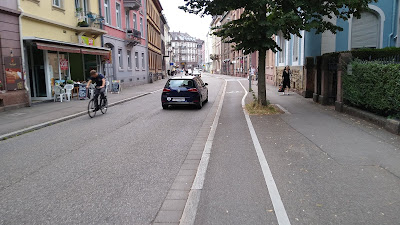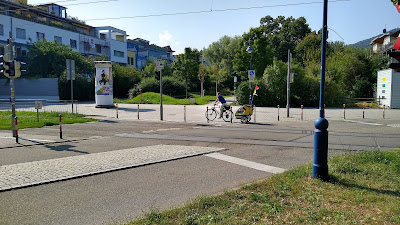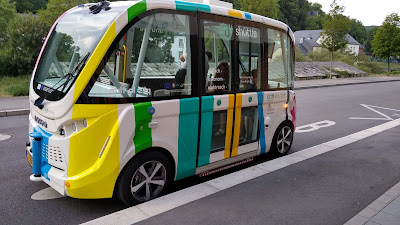A couple of weeks back, I took you on a little tour of Vauban, a neighbourhood in the southern German city of Freiburg im Breisgau. This week, I'm taking a look at the city centre itself.
There's no Google Streetview in Germany which is a disadvantage when trying to double check where one has been, but in common with many of the places we have visited on our mainland jaunts, we have stayed at campsites on the edges of cities where we have the ability to get to by car (5 of us and full camping kit), but to travel into the city by public transport and Freiburg was no different.
We stayed at Busses Camping on the edge of the city because it was a short (1km) walk to a tram stop and as mentioned in the previous post, we could also rent a Donkey Republic hire bike. We arrived on a Thursday afternoon and after getting set up, we were eager to head into the city. My son and I rented bikes and we met my wife and girls in the city as they went by public transport. On the Friday, my son and I cycled to Vauban and then met up with the others after. On both trips, we got the tram back.
Freiburg has an historic core surrounded by a ring road and a couple of large roads going out to join the motorway network. There is an extensive tram network in the city which connects the edges to the centre and at the city's station just to the west of the ring road, there is interchange with trams and buses. The tram and bus network is owned by the city's transit company VAG;
Cycling around the city is OK, but infrastructure is still designed around the car and some large junctions are quite intimidating such as here on Basler Straße with its lovely murderstrip;
We had been travelling along an OK cycle track (shared-use, segregated) and we needed to turn left towards Vauban. Our route meant we had to leave the track into a cycle lane between an ahead and left traffic lanes because we had to turn in two stages, despite the road layout and markings not being helpful. Many of the large junctions are like this and in dire need of work to make them feel safe. The main roads had cycle lanes and tracks, but quality varied meaning it was hard to relax.
There were also glimpses at some 1970's style engineering such as this underpass at Schwartzwaldstraße which tries to compensate for the large road running through the adjacent neighbourhood. In fact, the tram and the car compete for speed along this corridor to the east of the city showing it's possibly too easy to drive around;
Closer into the old city, the neighbourhoods are older and streets narrower and so there's quite a bit of filtering of traffic and contraflow one-way working making the layout quite familiar with other parts of Europe;
Although in many cases, it was all a bit inconsistent and we did feel exposed to poor driver behaviour in some places. There was some protection, but again, it was just painted lines on the footway;
It does rather seem like a bit of a basic network was built, but nothing has really been developed and things like this dropped kerb reminds us who the streets are for;
Still, there were plenty of people cycling and so at least that does show progress. I haven't cycled extensively in Germany, but what I saw wasn't vastly different to what I saw along the North Sea coast area, so it's not an isolated design issue;
In contrast to the edges and the area around the ring road, the city centre is completely different, although to get there you are lumped in with people on foot such as this toucan (two stage) crossing over Schlossburgring to the south-east corner of the old city;
However, once inside the old city the change is striking. There is some access to traffic, but the centre is largely the domain of walking and cycling with the odd tram going past (well, quite a few in some streets) and it is wonderful (and tricky to follow without Streetview);
The city centre streets are quite logically laid out with more defined walkways on the wider streets, clear space for cycle parking and of course the tramways;
One fascinating feature of the city centre is the network of rills which were originally built to supply water to parts of the city;
Freiburg's city centre is extremely walkable and walking-friendly. There are plenty of cobbles which are not always great walking surfaces, but the level of maintenance means that most of the time, they don't present a problem. There are also lots of hidden places where peace from the crowds can be found;
The quality of the paving is something for the budding kerbnerd to behold. Here we have the "carriageway" area to the left in smooth cobbles with a bitumen pointing to keep things nice and flat. A water rill and then a footway made from small stones which have been cut on half and bedded in to provide a flat walking surface;
I also loved the inset mosaics in front of businesses which explained what the business was, like this office for the city transit company;
Back out from the centre and back on a bike, there is also some interesting developments of bicycle streets (Fahrradstraße) which essentially prioritise cycle traffic with local access or other traffic restrictions. At junctions, the cycle route has priority and it means cycle speeds can be maximised;
Freiburg is definitely a place to visit for a few lazy days and the transport system and walkable city is a joy to use. If only the city could tame the car a bit more and build some decent cycle tracks on the main roads!





























































